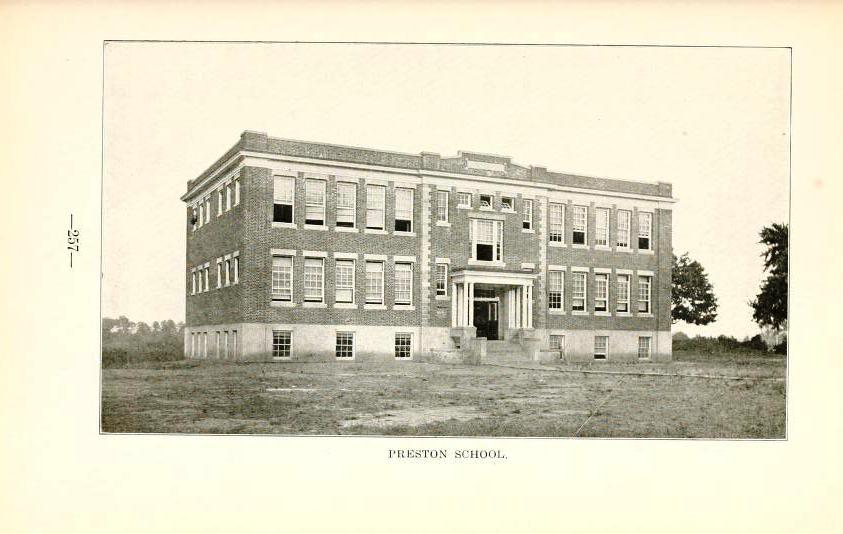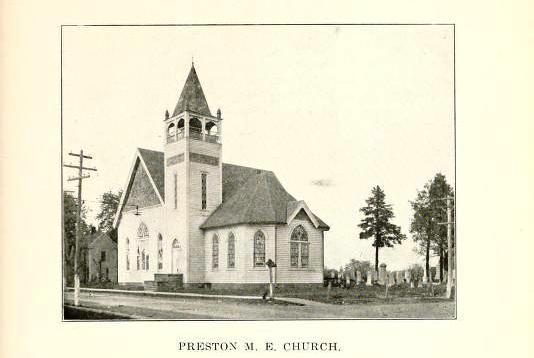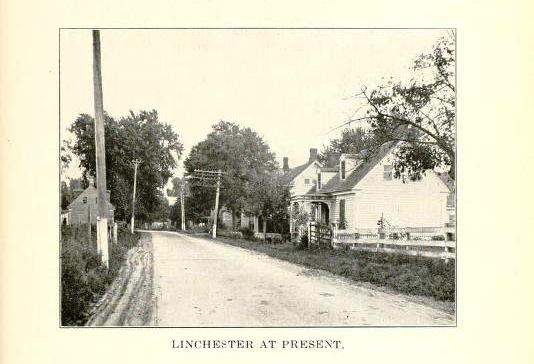The History of Caroline County, Maryland, From Its Beginning
Preston (Snow Hill), Linchester, Choptank
PRESTON
The founding of Snow Hill, the forerunner of Preston, likely took place
about 1845 at which time trees were cut and a clearing made where now
stands Preston.
It seems that the Willis family,
later well known in the section and county, was the holder of the land
hereabout. Philemon Willis the
ancestor of Peter Willis who was an
officer in the War of 1812, deed very early the site of the present M.
E. Church. William Gootee, one of the first
inhabitants of the new village, kept a store and included the post
office to which for miles around the people would come once a week to
get their mail if any there by and do their shopping.
As Snow Hill grew and the quantity of
mail increased, frequent delays in the service were made because of
there being another Snow Hill in Maryland, a much older and larger
village. Hence it became necessary to change the name. This
was done in 1856 while Mr. J. R. Stack of
this section was a member of the Legislature. Why the name Preston
was selected seems to be unknown, unless to memorialize some prominent
family in Maryland at that time. The name, however, was well
selected and continues to add dignity to the charms of this favored
section. Before 1890, the growth of this town was slow due to the
lack of transportation facilities, Medford’s Wharf, now Choptank, being
the shipping point of this section at that time. However in this
year the railroad was constructed and Preston began to grow.
In 1908 electric lights were added
and in 1916 the state road was completed thereby putting the town on the
main artery of traffic up and down the peninsula.
In education matters and sentiment
this section has always ranked high—explained no doubt in part by the
settlement of the community by Friends, a Society which has always stood
for education and enlightenment and latterly by the persistent influence
of the once famous debating society of this section. No one can
deny the fact that these two factors have been important elements in the
educational strata of this community.

The first school was said to stand on the road to Friendship, but later
the building was moved to a site near the present German church.
After a few years the front room of the old school building recently
sold was built and later from time to a room was added as the attendance
increased until the building became entirely inadequate to meet the
demands of a modern school. In 1918 after repeated efforts on the
part of several of the leading citizens of the town a handsome brick
building was erected on a lot of six acres which had been previously
provided for. The building committee was N. H.
Fooks, chairman; Chas. B. Harrison, Esq., and Walter
M. Wright.
A clipping from the Denton Journal explains the disposition of the older
school property located in what is now the church grove:
“The Rev. Thomas A. King, pastor of the New Jerusalem Church in Baltimore, and chaplain of the Grand Lodge of Maryland Masons, has brought the old academy building and the grove in which it is situated in Preston. He will remodel the house, which is a large one, and make it a summer residence for his family. It is in a magnificent grove of large primeval white oaks, so few of which now remain on the Eastern Shore. The wood covers 90 square perches of land. The house was built in 1863. Last year a new school house was erected in another part of the town. The first principal was Prof. R. O. Christian, who had just come out of the Confederate army and had no possessions but a battered suit of gray.”Because of the larger German population that had gradually come in the community a parochial school was established here years ago. In this school both English and German languages as well as church forms were taught by the pastor of the church who had charge. As many of the German patrons had become interested in the public school for one reason or another this private school was closed about three years ago.
CHURCHES
The history of the Friends Society in this community may be found
elsewhere in this volume under the heading—Early Churches.
Years ago a German Lutheran Church
was established here and is well attended. Service was formerly
held in both the English and German languages.

PRESTON’S EARLY CHURCH
Among the earliest Methodist records in our county appear the names of William
Frazier and Bethesda Chapel. Largely due to the
efforts of Captain Frazier was the
erection of this chapel on the present sit of the Preston Methodist
Church. In July of 1797 Thomas Foster, James
Andrew, David Sisk, James Sisk, Jacob Wright,
Benjamin Collison and Daniel Cheezum,
trustees of the church, purchased from Philemon Willis for the sum of 10
shillings the half acres of land on which the chapel stood. Frazier,
although not one of the trustees, probably arranged for the purchase of
this land and his name with that of Thomas Weir
Lockerman is given as testator of the deed. In
1810 the church was incorporated in accordance with the provisions of
the Maryland Assembly with trustees forming the body politic.
In the Bethesda Record Book, kept
since 1810, there are several interesting items concerning the Chapel.
A colored people’s class was held there on Sunday mornings preceding the
regular preaching services, a custom not unusual at that time. The
duties of the sexton as outlined in the minutes were as follows:
“Chop wood, make fires, keep house clean and in order, the benches and pulpit well dusted, with a pitcher of water on the pulpit with a tumbler during church hours, keep lamps trimmed and clean, windows to be kept clean and shutters closed during the week, the premises kept clear of encumbrances.”The carpet were to be taken up and the house scoured twice a year. For all this the sexton received the princely sum of twelve dollars a year.
With the growth of the little town then known as Snow Hill a larger church was needed. It was built about 1847 from which time it became known as Bethesda Church. Ten years later the church yard was enclosed as a burying ground for Methodists of that section.
Repairing and remodeling done in 1888 and 1903 have greatly enlarged and improved the building, which is as present an up-to-date church of considerable size.
LINCHESTER
This village, formerly called Murray’s Mill, is on the site of one of
the first settlements within the boundaries of Caroline County.
During the Revolutionary War, this
mill still in existence, did its share towards furnishing food to the
soldiers not alone in this section but for a very large territory.
Large scows could at that time come direct to the mill and be loaded
with flour and meal to be reloaded on larger vessels on the Choptank
River.
There must have been a store or two
kept here at that time. Likewise an ordinary (boarding house)
which was licensed by the County court. Before 1775 people from
this section attended the old Episcopal chapel that stood on the road
leading from what is now known as Ellwood camp to Hynson and near the
latter place. This church like others of the same denomination was
practically closed by the Revolutionary War, and as its successor in
this community the meeting at William Frazier’s home
was organized.
Through the influence of Robt.
D. Bradley, once a member of the Maryland Legislature, the name of
the place was change to Linchester—the Lin being taken from Caroline and
Chester likewise from Dorchester, these two counties forming a boundary
at this point.

CHOPTANK
This name, given to the most southern village of Caroline County on the
Choptank River, dates back to about 1889 when it was known as Medford’s
Wharf and even then was in daily communication with Baltimore by two
lines of steamers. Later on, three steamers daily left its wharves
for our Metropolis.
About 1882 or 1883 the Wright brothers
located here, along with some earlier settlers, and started some
enterprises which caused the settlement to grow rapidly. The post
office was established about the time the name was changed to Choptank.
Formerly the children of this section
attended a school called Hunting Creek located some distance away.
About 1892 a large school building was erected at Choptank.
A little earlier two churches were
erected—Methodist Episcopal and Methodist Protestant.
The village is noted for its
fisheries, perhaps, the best in the county. As many as 60,000
herring and shad are said to have been caught in a single day.
The inhabitants number about 200.